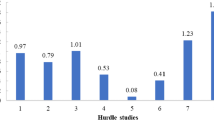Abstract
Anthocyanin-rich concentrates from different fruits can be used as natural food colourants. The pigments' stability is comparatively low and dependent on the composition of food matrices. Food ingredients relevant for soft drinks, jelly fruits and salad dressings were tested in model systems regarding their influence on the colour stability of elderberry and black currant concentrate determined by colour measurement (CIE L * a * b *). In aqueous solutions food-grade organic acids and salt were found to influence anthocyanin stability: colour stability increased with increasing pK a of acids and decreased with increasing salt concentrations. This may be attributed to altered solvation characteristics of aqueous solutions. A stabilizing influence was found for sugars presumably by reducing water activity. However, when heat treatment was applied, e.g. in the production of hydrocolloid gels, fructose was shown to accelerate anthocyanin decay due to the formation of sugar degradation products. Comparing hydrocolloids, alginate was shown to increase colour stability in aqueous solution and pectin displayed overall highest colour stability in a gel model system, suggesting that polyuronic acids may improve anthocyanin stability by intermolecular association.





Similar content being viewed by others
References
Brouillard R (1982) Chemical Structure of Anthocyanins. In Markakis P (ed) Anthocyanins as food colors. Academic, New York London Paris, pp 1–40
Jackman RL, Smith JL (1996) Anthocyanins and betalains. In Hendry GAF, Houghton JD (eds) Natural food colorants, 2nd edn. Blackie, London Glasgow, pp 244–309
Hubbermann EM (2005) Functional properties of anthocyanin concentrates and the influence of physicochemical parameters and food additives on the color and stability of isolated anthocyanins in food matrices. University Dissertation, Der Andere Verlag, Tönning Lübeck Harburg
García-Viguera C, Zafrilla P, Artés F, Romero F, Abellán P, Tomás-Barberán FA (1998) J Sci Food Agric 78:565–573
García-Viguera C, Zafrilla P, Romero F, Abellán P, Artés F, Tomás-Barberán FA (1999) J Food Sci 64:243–247
Rein MJ, Heinonen M (2004) J Agric Food Chem 52:3106–3114
Katsaboxakis K, Papanicolaou D, Melanitou M (1998) Ital J Food Sci 10:17–25
Garzón GA, Wrolstad RE (2001) Food Chem 75:185–196
Skrede G, Wrolstad RE, Lea P, Enersen G (1992) J Food Sci 57:172–177
Jurd L (1972) Some advances in the chemistry of anthocyanin-type plant pigments. In Chichester CO (ed) The chemistry of plant pigments. Academic, New York London, pp 123–142
Poei-Langston MS, Wrolstad RE (1981) J Food Sci 46:1218–1222, 1236
Duhard V, Garnier J-C, Megard D (1997) Agro-Food-Ind Hi-Tech 8:28–34
García-Viguera C, Bridle P (1999) Food Chem 64:21–26
Calvi JP, Francis FJ (1978) J Food Sci 43:1448–1456
Meschter EE (1953) J Agric Food Chem 1:574–579
MacKinney G, Lukton A, Chichester CO (1955) Food Technol 9:324–326
Tinsley IJ, Bockian AH (1960) Food Res 25:161–172
Daravingas G, Cain RF (1968) J Food Sci 33:138–142
Debicki-Pospisil J, Lovric T, Trinajstic N, Sabljic A (1983) J Food Sci 48:411–416
Goto T, Hoshino T, Ohba M (1976) Agric Biol Chem 40:1593–1596
Dangles O, Brouillard R (1992) Can J Chem 70:2174–2189
Figueiredo P, Pina F (1994) J Chem Soc Perkin Trans 2:775–778
Cabrita L (1999) Analysis and stability of anthocyanins. PhD Thesis, University of Bergen, Norway
Shi Z, Lin M, Francis FJ (1992) J Food Sci 57:758–760, 770
Garzón GA, Wrolstad RE (2002) J Food Sci 67:1288–1299
Sondheimer E, Kertesz ZI (1952) Food Res 17:288–298
Iacobucci GA, Sweeny JG (1983) Tetrahedron 39:3005–3038
Hoshino T, Matsumoto U, Goto T (1981) Phytochemistry 20:1971–1976
Taoukis PS, Breene WM, Labuza TP (1988) Intermediate moisture foods. In Pomeranz I (ed) Advances in cereal science and technology, vol IX. AACC, St. Paul, pp 91–128
Lewis CE, Walker JRL, Lancaster JE (1995) Food Chem 54:315–319
Belitz H-D, Grosch W (1999) Food Chemistry, 2nd edn. Springer, Berlin Heidelberg New York
Robinson R, Robinson GM (1939) J Am Chem Soc 61:1605–1606
Robinson GM (1939) J Am Chem Soc 61:1606–1607
Asen S, Stewart RN, Norris KH, Massie DR (1970) Phytochemistry 9:619–627
Bayer E, Egeter H, Fink A, Nether K, Wegmann K (1966) Angew Chem Int Ed Engl 5:791–798
Acknowledgements
The authors would like to thank Anschi Saß for technical assistance regarding the gel systems. This work was supported by the Commission of the European Communities' Quality of life and management of living sources specific RTD program “Functional Properties, Bioactivities and Bioavailability of Phytochemicals, especially Anthocyanins, from Processed Foods,” QLK1-CT-1999-00124. It does not necessarily reflect its views and in no way anticipates the Commission's future policy in this area. The authors are grateful for the research grant of EMH by the International Foundation for the Promotion of Nutrition Research and Nutrition Education (ISFE).
Author information
Authors and Affiliations
Corresponding author
Rights and permissions
About this article
Cite this article
Hubbermann, E.M., Heins, A., Stöckmann, H. et al. Influence of acids, salt, sugars and hydrocolloids on the colour stability of anthocyanin rich black currant and elderberry concentrates. Eur Food Res Technol 223, 83–90 (2006). https://doi.org/10.1007/s00217-005-0139-2
Received:
Revised:
Accepted:
Published:
Issue Date:
DOI: https://doi.org/10.1007/s00217-005-0139-2




